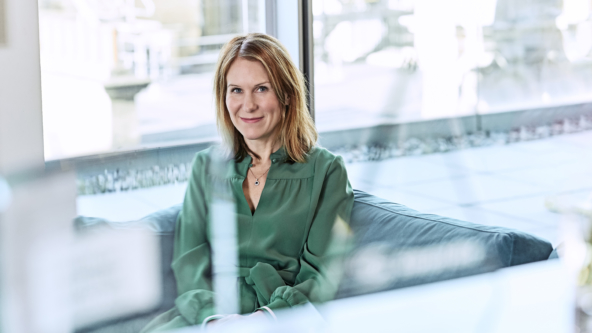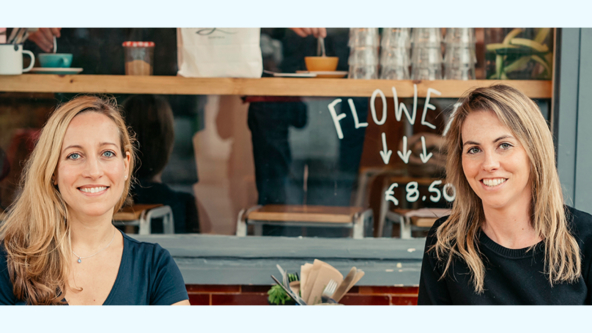Earlier this year, Octopus sponsored Women In Leadership, a report published by the All-Party Parliamentary Group for Entrepreneurship. Together with Octopus Ventures, we asked female entrepreneurs to tell us about the challenges women in leadership face on a daily basis.
“I fell pregnant with my second child as I was raising money,” explains Tania Boler, co-founder and CEO of women’s healthtech company Elvie. “My co-founder was fully supportive and, actually, you have to just surround yourself with people who are. If an investor minded that I was raising a family, they weren’t for us.”
Tania went back to work a week after giving birth, taking her baby into the office, to board meetings – wherever she needed to be. “As Elvie’s founder, I could be completely flexible, but it’s not easy and women get judged so much. It’s incredibly tough to be a woman in leadership anyway, and you can’t really talk about the stresses at home because you’re running a business. And when you are at home, you’re the primary caregiver.”
Last year, Tania and her team raised £5 million (their Series A) from Octopus Ventures, which has one of the most impressive track records of investing in female founder companies in the UK.
In 2016, 29 per cent of its new portfolio companies were female-led. In 2017, that was up to 33 per cent, and this year, it’s 40 per cent to date.
Talk to the entrepreneurs that Octopus chooses to back, and there’s clearly a reputation dynamic at play: if you’ve got a choice between investors, they will say go with Octopus. “The female founder ecosystem is still relatively small, so recommendations go a long way,” says George Whitehead, Head of Investor Relations at Octopus Ventures.
Writing your own story
Fundraising can throw up unique barriers for female founders. An All-Party Parliamentary Group report entitled Women In Leadership, sponsored by Octopus and surveying over 500 entrepreneurs, found that just 16 per cent of companies with a female founder had secured funding between 2009 and 2017.
As the report points out, some of this can be explained by the kinds of businesses female entrepreneurs choose to build – many want to work on lifestyle businesses. Yet while a proportion are happy to grow their business organically, and not divest of their stake in order to take more funding, surveys demonstrate that male and female entrepreneurs show similar levels of ambition around scaling their start-up.
Some studies suggest that women have a harder time fundraising via traditional routes because of unconscious bias. A series of randomised controlled trials, conducted at Harvard Business School, revealed that a female name, picture or voice cuts the odds of receiving investment.
“We are a triple whammy for most investors,” says Tania. Elvie makes smart, connected hardware to improve women’s health and wellbeing. Its first product was a pelvic floor trainer; it’s second, released last month, a silent, wearable breast pump. “Certainly in investment, there is a hardware scepticism. Then, it’s products only for women – and intimate ones, too. We’re also part of the personalised health generation, which is still uncharted territory.”
For Tania, it makes a “big difference” if she’s pitching to women. “But male investors will increasingly understand the need too, because they have wives and daughters, and these topics are finally being brought out into the open.”
“There is a strong economic and moral case for ensuring women-led businesses are more represented in the fastest growing sectors of our economy.”
Seema Malhotra MP, Vice Chair of the APPG for Entrepreneurship
Anticipating objections
Caroline Plumb, co-founder and CEO of AI-driven cash flow and forecasting software company Fluidly, another company backed by Octopus Ventures, explains how she has always tackled pitching hurdles head-on. “If you’re going to pitch anything, you need to have a pretty good sense of what the objections are going to be – including the unspoken ones. My background was building businesses in other sectors; I also had a young family at home. That just meant I had to be ready for questions that were going to be asked, and what everyone will be thinking: ‘Does she know anything about finance?’; ‘Tech?’ ‘Does she have enough ambition to grow a really big business?’; ‘How is she going to make the family thing work?’”.
Caroline says the key here – and the strategy she recommends to other female founders – is to build a story that covers your professional and personal motivations. “I crafted my opening two to three minutes to speak to all those objections. I have an engineering degree, a life-long love of tech. I would then talk about running and scaling my previous business and how that gave me exposure to the pain point I was trying to solve – financial planning and forecasting for SMEs. Then I’d talk about my motivations for setting up a new business now: that I had completed my family, and it was the right time to do it. As a woman, it can be hard to find a way to address those, often unspoken, objections. But you can do so in a comprehensive but gentle way.”
On the other side of the table, many investors are working to change. Octopus Ventures is one of a handful of UK VC firms that have agreed to track and hand over anonymised data on the start-ups they meet with to Diversity VC, an initiative that seeks to build a more diverse venture capital industry.
“When you’re pitching, you like to think that the person on the other side of the table is a potential role model or someone you could work alongside. Funds are now putting up their hands and saying that, historically, that can’t have always been the case because for many funds on the investor’s side of the table it was always only elderly white males making the investment decisions,” says Zoe Chambers, Early-stage Investor at Octopus Ventures.
When hiring, Octopus chooses to ask four questions of candidates, about the role and themselves, to avoid unconscious bias. “We’re purposefully trying to hire people who are different to us,” says George. “Given the role VCs play in the economy, we see diversity of thought as vital. We’ve found that people you’d assume, from their CV, will be dead certs, are not – and vice versa.”
In 2017, VCs invested $155 billion worldwide, determining makes-or-breaks for companies that can fuel growth, innovate, and change the lives of consumers.
Putting sex in ‘sexy tech’
For Tania Boler of Elvie, the substance of her business throws into sharp relief the opportunities female entrepreneurs can capitalise on – particularly in the tech sector. “Women are early adopters of tech, and historically their needs have been overlooked in favour of the baby, and the male consumer. We’re building innovative products that change that,” says Tania.
Elvie collects biometrics, feeding women real-time data about their health. “The vast majority of medical devices are badly designed – because they weren’t designed with the end user in mind. Our team includes former Apple and Dyson employees, because a better consumer experience, enabled by technology, is what we want to achieve.”
Mercifully, the “lipstick mumpreneur”-speak that has shaped the women in leadership conversation – certainly in the media – is waning.
“There are the sectors that are seen as shoo-ins for female entrepreneurs, such as fashion and beauty,” says Zoe Chambers. But increasingly, the focus is – and should be on – areas where women are still in the minority, like deep tech, she adds.
In addition to Fluidly, Octopus Ventures is also an investor in GTN, a female-led and founded company that uses a combination of machine learning and quantum physics to speed up drug discovery. “We see part of our role as giving women an indication of what’s possible, and inspiring them,” Zoe Chambers adds. “Part of doing that means working with higher education institutions, even schools, and ensuring a positive message is broadcast to women and girls.”
Women in Leadership proposes more data collection on Science, Technology, Engineering and Mathematics (STEM) drop-off rates, with breakdowns on age and region and regular publication to ensure the government can implement policies where most needed.
Currently, the report notes, women make up just 14.4 per cent of all people working in STEM in the UK, far short of the country’s goal of a critical mass of 30 per cent.
“It’s a sensible recommendation,” says Caroline Plumb, whose engineering team at Fluidly is one-third women. “We don’t and would not actively use quotas, but we do reach out to groups that encourage women in the industry. I find the drop-off figures hard to believe because I loved science and still do!”
The drop-off rates among girls in STEM subjects is something of an enigma, because they tend to perform better than boys academically, outperforming at GCSE-level but then dropping these subjects post-16.
One argument, prompted by a Europe-wide survey cited in the report, is that there are a lack of female role models in STEM. “This is why it’s important that organisations like Octopus are there to help at every point of the spectrum” says Zoe Chambers. “If there are exciting PhDs working on brand new technology, and we can help them build a business, we want to be there to support them.”
Beyond data
Often, examples from inside the four walls of a business best demonstrate bucking the trend, and provide inspiration. “One of my software engineers is a career-changer. She hadn’t read science but had a first-class languages degree. She retrained, and she’s brilliant,” says Caroline Plumb.
Such experiences highlight how focusing on the right company culture, rather than turning to quotas or diktat, helps leaders attract and retain all talent. And this plays out when it comes to maternity (and paternity) leave and childcare.
Tania Boler stresses that a lack of childcare remains a key issue in the UK. “People want to prioritise their children. Our Head of Operations, for example, wanted to spend more time at home. We wanted to keep her, so went out and advertised for a job share. Now we have two fantastic women sharing that role. It’s one of the best ways, as an employer, that you can help women progress their careers: offer them flexibility and time at home.”
The Octopus Ventures team had a similar scenario when Simon King, one of their principals and a board member for Elvie, wanted to take extended paternity leave. “We were all told ‘no-one bother this man! As a team, whatever it is, we can pull together and sort it,’” says Zoe Chambers.
Instances like this stand testament to how the treatment of female founders – and women in leadership – form part of a wider conversation about the kinds of places in which we want to work, and what the work/life balance should look like in the twenty-first century.
At the same time, it is clear that effective policy and initiatives have to be based on fact, and that means increasing and improving data collection.
The salient recommendation of Women in Leadership is the improvement of data collection on business ownership, with a call for comprehensive and regularly updated gender-disaggregated ownership data. “What gets measured gets done,” says Caroline Plumb.
While the likes of Diversity VC are shining an invaluable spotlight on venture pipeline data, there are large, important areas of the start-up ecosystem yet to be looked at. “A bugbear of mine is the complete lack of data on limited partners,” she adds. “That data should be collected alongside the makeup of firms, their pipeline, rejection rates. A lot of limited partners are pension funds, and the British Business Bank, which is taxpayers’ money, is cornerstoning many of them. It should be demanding data of them, and exerting more influence.”
And then there are questions around decision-making roles and longevity within businesses. “Part of the issue is that female founder numbers only tell you some of the story,” says Tania. “Often, you’ll get founder teams of, say, four and one of them is a woman. She is not the CEO, though. How many businesses are founded by women and led by women?”
In 2016, around 163 million women were starting or running new businesses in 74 economies across the world, yet under two-thirds of these businesses could be described as ‘established’. Meanwhile, in Canada, where the data is available, just 10 per cent of companies with 100 employees or more are owned by women.
“I’m an optimist,” says Tania Boler. “A lot of the challenges we face now are a function of time.” The number of women-owned businesses in the US grew by 74 per cent between 1997 and 2015. “We will see more female entrepreneurs, and female entrepreneurs who scale their business and remain in charge. The issues are the same: it’s about focus, and building the right team.”
“If the Government wants our businesses to compete on global markets after Brexit, it has to break down the barriers facing female entrepreneurs.”
Chris Hulatt, Octopus Group,
Women in Leadership Report, published 2018
A female founder future
Helping to maximise the potential of current and future female entrepreneurs is “really hard to put policy around,” says George Whitehead. “Part of the answer lies in supporting the many great initiatives already making a difference, whether that’s women-led funds, angel-led funds that focus on women, mentoring programmes… the sorts of things that have been built up over the years to support entrepreneurs wholesale, but specifically for women.”
The crux of much of the conversation around female entrepreneurship stresses the value of networks. Women in Leadership emphasises that, in addition to more limited access to finance, women who hold leadership roles frequently have less access to networks than male counterparts, and that networking events can favour men. “It’s a really important area because women can go on maternity leave and their network can weaken,” says Caroline Plumb.
“I always advise other women going on maternity leave to keep a pilot light on. If it goes out, it’s going to be really hard to reignite it, but if you can, find the time, particularly when you’re younger, to go out, go to events, pay it forward and build your network. Have the boldness to connect with someone, even if you don’t know them that well.”
Boldness, confidence and higher levels of self-belief are not easily quantifiable things. But every founder has to be persistently bullish about their business, and about themselves, so they are key in a discussion around how to help female-led companies scale. “Women can struggle more than men when selling their business,” says Zoe Chambers. “That’s why we focus on giving all of our founders the tools they need to go and build things and have the confidence to tell people. And as you progress through funding rounds, pitches become increasingly driven by numbers, which can speak for themselves.”
Prompting a sea change
Plainly, there is work for government and industry leaders to do. The need for more data, to inform the right ways forward, is obvious. Moreover, sensible liberalisation, like removing the Keeping In Touch restriction on women receiving Maternity Allowance, which sees them forfeiting the benefit if they work more than ten days during the 39-week Maternity Pay Period, could make life so much easier for women in leadership. “I definitely maxed that out, and I would’ve done more,” says Caroline, who suggests return-to-work bonuses as a method of encouragement, rather than punishment.
But speaking to the Octopus Ventures team, and speaking to female founders themselves, it is clear that what changes women’s lives is the decisions made by other individuals – their bosses, colleagues, others in their network.
Embedding the needs of a workforce into the company, seeking difference rather than similarity, and acknowledging that enabling women, even if it does mean a head or two above the parapet, can have positive unintended – as well as intended – consequences.
“If we’d have had this interview when we started up four years ago, I wouldn’t have felt comfortable talking about the realities of being a female founder. It would have felt too risky,” says Tania Boler.
“But what we’ve achieved with the support of Octopus – from our commercial results, to our partnership with the NHS… I’ve now got a long list that says ‘this is possible’. For any women out there saying ‘I can’t do it; I can’t juggle running a business and motherhood: you can. We can all go out there and prove people wrong. And as we become more successful, we’ll build our teams differently, and make sure that prioritising and supporting women is top of our agenda.”
Read the Women in Leadership report here.


